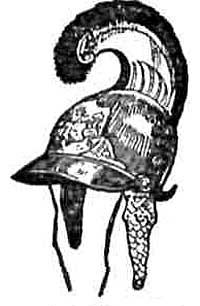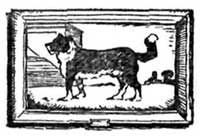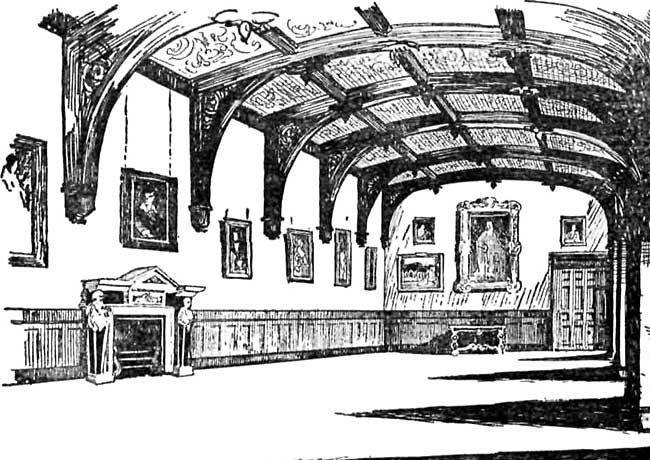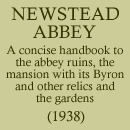
Byron's Helmet.

Boatswain, the Newfoundland, 1803-08.
Leaving the Prior's Dining-Room, we must turn back for a step or two into the Large Dining-Hall in order to pass through the carved doorway leading to the West Corridor, on the wall are hung many relics which were absolutely personal to Lord Byron and are now conveniently displayed for the inspection of visitors. A glass case upon the wall should be especially noticed as it contains old Deeds and Pardons associated with the ancient Priory of Newstead. These Deeds and Pardons were put inside the Brass Eagle, which is now the lectern at Southwell Cathedral, and thrown into the Eagle Pond where they lay for about 250 years. The corridor is a long handsome gallery whose window* overlook the Cloister Garth.
As we pass up the short flight of stairs at the south end of the Corridor on our way to the Great Drawing-Room, we may notice on the wall above the stairs a painting of "Boatswain," the beloved Newfoundland dog made famous by Byron's pathetic lines and by the monument in the gardens upon which the poem is inscribed (we shall visit the monument on our tour of the gardens later). Opposite to "Boatswain" is a painting of the "wolf dog" which also belonged to Lord Byron; this is dated 1809 ("Boatswain" had died in the previous year).
The Great Drawing-Room is a splendid apartment indeed, measuring 75 feet long by 35 feet wide. The carved design of the white marble fire-place illustrates the story of Androcles and the lion—Androcles being shown in the act of extracting the thorn from the lion's foot. Above the fire-place hangs the celebrated portrait of the poet#— George Gordon, 6th Lord Byron—by Thomas Phillips, R.A., which has been reproduced times without number. There are several other interesting portraits in this room, while at one end of it stands a magnificent Florentine table,* most richly decorated in coloured marbles of great brilliancy. As a work of art it is remarkable enough, but in addition it may be said that the birds and insects which form the chief components of the design are carried out with marvellous fidelity to their true details of form and colour, instead of being treated with the unscientific "freedom" usually indulged in by decorative artists when handling such motifs. The ceiling of this fine chamber is also Italian work, dating from 1635; the panels between the massive oak framing are embossed in white plaster against a blue background, giving a distinctly unusual decorative effect. The portrait of Lord Byron is part of Mr. Fraser's gift to the Nottingham Corporation, the other furniture and pictures in this room are on loan to the Corporation by Mr. Fraser.+

The Great Drawing-Room.
Returning to the Corridor and passing along the full length of it, we find ourselves at the foot of a spiral stone staircase. This leads up to three small rooms intimately associated with Lord Byron and forming, as it were, the central shrine of Newstead for those visitors who are primarily interested in the literary associations of the place. At the head of the little twisting staircase we enter Byron's Dressing-Room.
* This portrait is
now (1938) hung in the Prior's Dining-Room.
# Now (1938) in the Dining Hall.
+ N.B.—In the Great Drawing-Room is now (1938) assembled the Roe-Byron
Collection, of which a descriptive guide and catalogue (188 pages) has
been compiled by the Nottingham Corporation. Copies of this catalogue may
be obtained from the Guide, price two shillings each. Enquiries relative
to the Roe-Byron Collection should be addressed to the City Librarian,
Nottingham.
